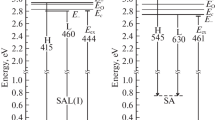Abstract
Using cathodoluminescence measurements between 80 and 300 K, we have investigated the temperature, injection level, and frequency dependences of three extrinsic luminescence bands in nominally undoped ZnTe. At 80 K, our material shows strong edge emission and broad extrinsic bands near 1.59 eV and 2.08 eV. The peak position and band shape are independent of injection level for both these extrinsic bands. 80 K measurements of frequency response from 50 Hz to 50 MHz show that the 2.08 eV band has an exponential time decay with a time constant of 0.045 μsec. The 1.59 eV band shows a more complex frequency dependence which indicates that one component of the response has a time constant of 1.85 μsec. At temperatures above 80 K the 2.08 eV band quenches with an activation energy of 0.22 eV which indicates that the transition originates near a band edge. In contrast, the 1.59 eV band does not quench with a well-defined activation energy. The peak of the 2.08 eV band follows the temperature dependence of the edge emission energy, whereas the peak of the 1.59 eV band shows the opposite behavior. From the 80 K measurements, we conclude that the 2.08 eV band results from a conduction-band-to-acceptor transition, and that the 1.59 eV band results from an intracenter transition between localized levels of a compact complex. Above 160 K, a third extrinsic band begins to appear near 1.80 eV. This band becanes increasingly prominent with increasing temperature. The frequency dependence of the 1.80 eV band at 166 K indicates an exponential time decay with a time constant of 0.37 μsec. However, the frequency dependence changes with temperature and a faster component appears in the response at 300 K. We conclude that 1.80 eV band near 160 K results primarily from an intracenter transition in a compact complex, and that there is a contribution from free-to-bound transitions at 300 K.
Similar content being viewed by others
References
W. R. Woody and J. M. Meese, J. Appl. Phys.47, 3640 (1976).
G. P. Yablonskii and V. P. Gribkovskii, J. Appl. Spectroscopy18, 234 (1973).
F. J. Bryant and A. T. J. Baker, Phys. Stat. Sol (a)11, 623 (1972).
F. J. Bryant and A. T. J. Baker, in Luminescence in Crystals, Molecules, and Solutions, Ed. by F. Williams, (Plenum, New York, 1973), p. 250.
N. Wantanabe and S. Usui, Japan J. Appl. Phys.6, 1253 (1967).
S. I. Radautsan, A. E. Tsurkan and V. I. Verlan, Bull. Aca. Sci. USSR, Physical Series,40, 10 (1976).
B. L. Crowder and G. D. Pettit, Phys. Rev.178, 1235 (1969).
C. B. Norris, C. E. Barnes and W. Beezhold, J. Appl. Phys.44, 3209 (1973).
T. L. Larsen, C. F. Varotto and D. A. Stevenson, J. Appl. Phys.43, 172 (1972).
C. B. Norris and C. E. Barnes, Rev. Phys. Appl.L2, 219 (1977).
Author information
Authors and Affiliations
Rights and permissions
About this article
Cite this article
Norris, C.B. Temperature, injection level, and frequency dependences of some extrinsic luminescence bands in ZnTe. J. Electron. Mater. 8, 733–748 (1979). https://doi.org/10.1007/BF02651182
Received:
Issue Date:
DOI: https://doi.org/10.1007/BF02651182




